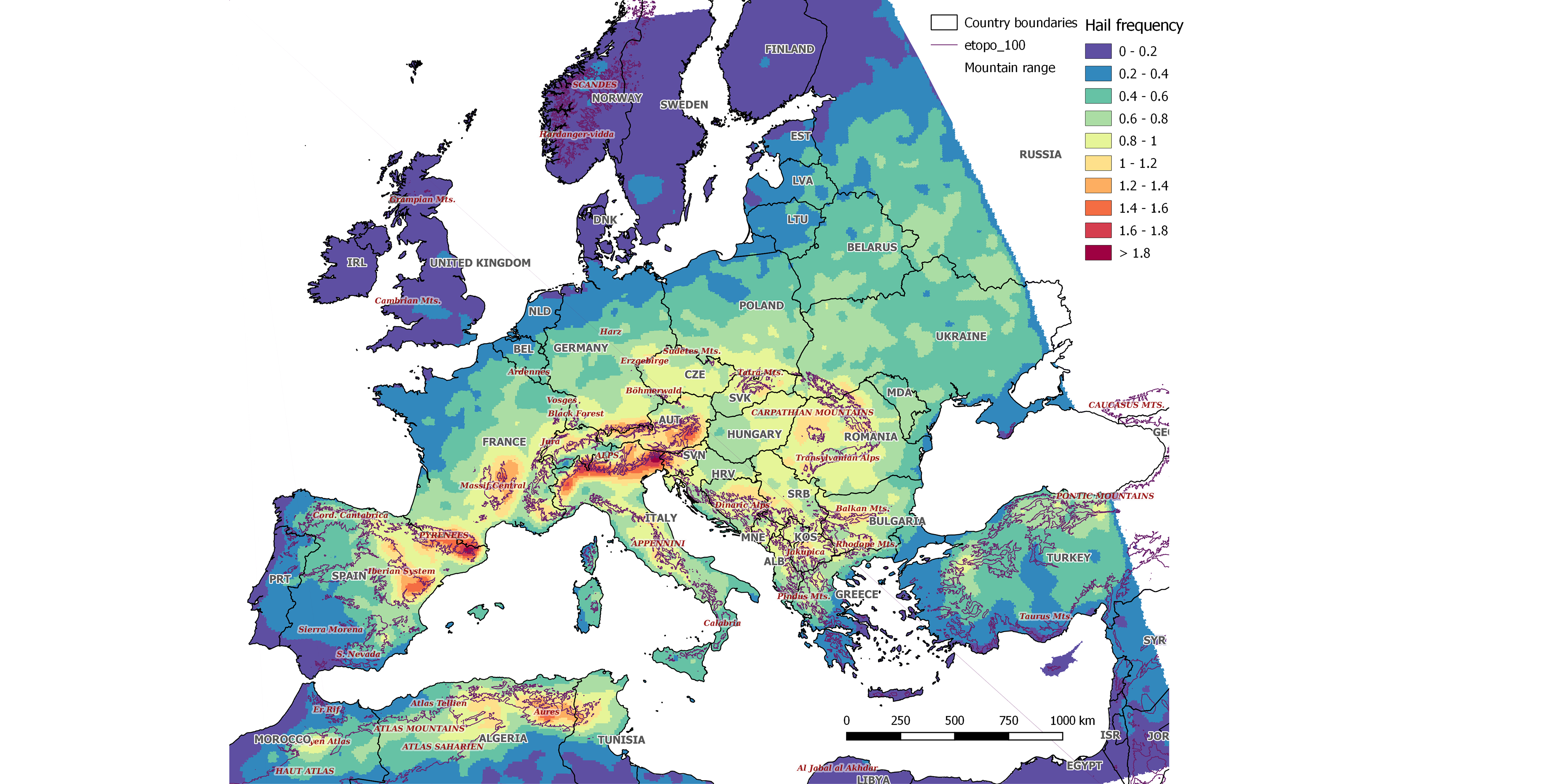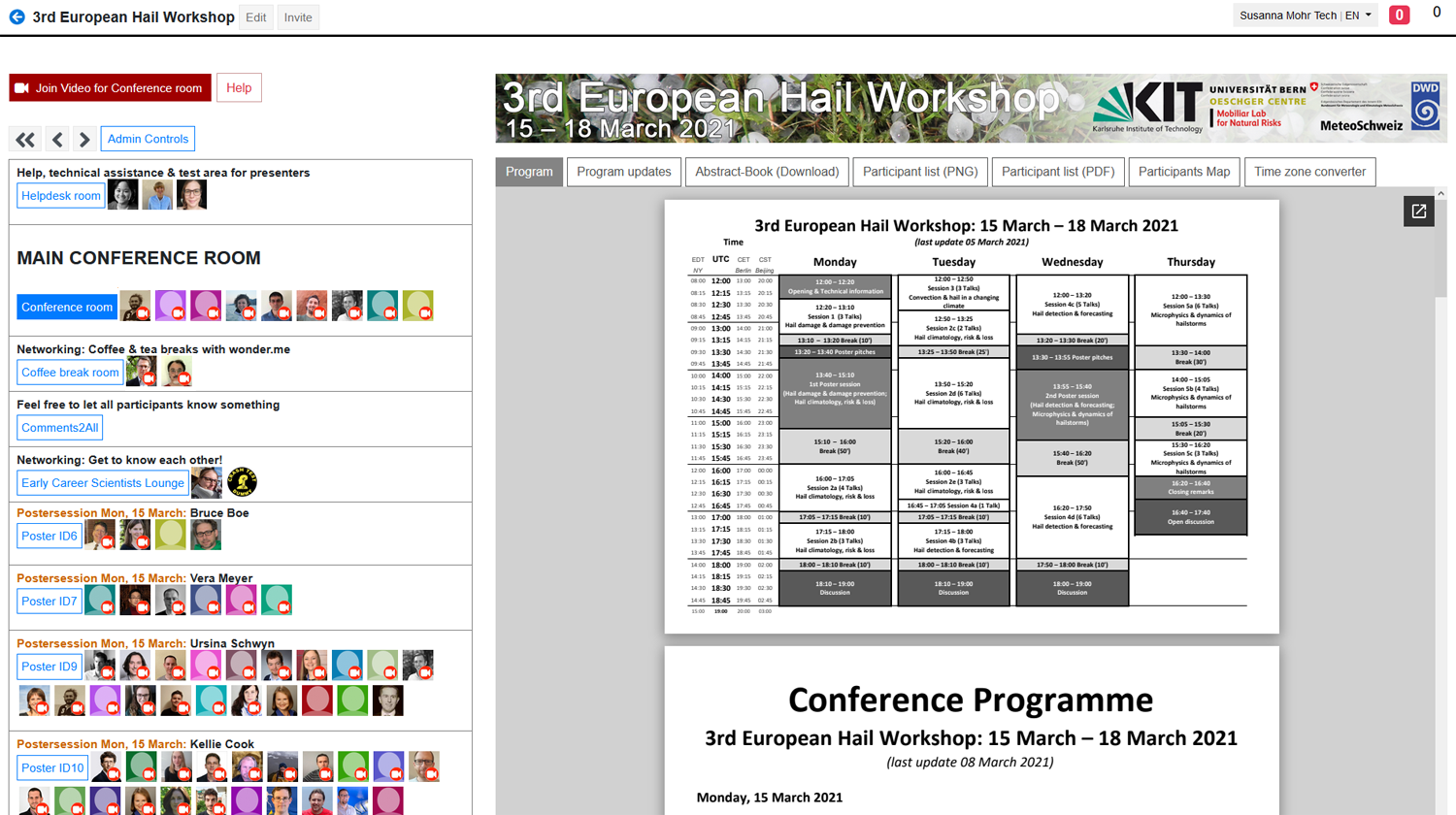Hail: Danger from the sky grows
Fig. 1: Hail frequency in Europe, derived from satellite data and model data (2004-2014).In Germany, particularly the south is affected, mainly on the lee sides of mountain ranges (Graphic: Dr. Heinz Jürgen Punge, KIT).
Hailstorms cause severe damage – and as a result of climate change, they are expected to occur more frequently and more intensely in the future. To discuss the current state of hail research, the Institute for Meteorology and Climate Research – Department Troposphere Research (IMK-TRO) hosted the 3rd European Hail Workshop in online format from March 15 to 18, 2021. This brought together more than 180 experts from atmospheric research, weather services, insurance, industry and agriculture virtually.
Hailstones that form in thunderstorms often reach diameters of several centimeters. As a result, severe hailstorms pose significant risks to people, buildings, vehicles and agricultural crops. Within a few minutes, damage can amount to billions of dollars. As a result of climate change, hailstorms are expected to be more severe in most regions in the future and to occur more frequently in some regions, including Europe. This is reported by researchers of the IMK-TRO at KIT together with scientists from Australia, Switzerland, the USA, and China in the journal Nature Reviews Earth & Environment (doi:10.1038/s43017-020-00133-9). Man-made global warming is projected to increase near-surface atmospheric moisture and thus atmospheric instability, which increases the probability of hailstorms and allows the formation of larger hailstones. Because hailstorms are relatively rare overall and also geographically limited, there is still a lack of data from long-term observations and high-resolved simulations needed for a comprehensive understanding of the effects of climate change on hailstorms.
Research improves short-term forecasting / nowcasting
Knowledge about the precise causes of hailstorms, their relationship to climate change, regional probabilities, and associated risks is still insufficient. Even the forecasting of such events using numerical models on different time scales, for example in the short-term range up to twelve hours, is still associated with major uncertainties. Therefore, researchers and various stakeholders are all the more interested in an interdisciplinary and international exchange. Thus, IMK-TRO, together with the Oeschger Centre for Climate Change Research (OCCR) and the Mobiliar Lab for Natural Risks of the University of Bern, as well as the weather services MeteoSwiss and the German Weather Service (DWD), organized the 3rd European Hail Workshop in digital format from 15 to 18 March 2021.
Workshop brings together academia and industry
At the workshop, researchers from the fields of natural and engineering sciences as well as experts from weather services and insurance companies, from industry and agriculture discussed the current state of hail research. Among the topics addressed were deficits and possible solutions in hail modeling and hail analysis, the improvement of methods for determining hail signals from remote sensing instruments (radar, satellite, lightning detection), the question of which processes are particularly modified by climate change, and under which environmental conditions large hail is preferably produced in different regions of the earth. The workshop also aimed to foster a direct scientific exchange and collaborations and to strengthen international cooperation.
Fig. 2: Participant map of the 3rd European Hail Workshop. In total, 184 participants from 24 countries and all continents attended the workshop.
In total, 184 participants from 24 countries or from all continents participated in the workshop. In order to further expand the link between science and industry, the 3rd European Hail Workshop was also aimed at engineering companies that deal, for example, with the hail resistance of building materials. This is because the exchange between different disciplines and application areas is a precondition for further developments in important topics, such as the improvement of forecasting and nowcasting for the range of ten minutes to two hours, as well as for effective measures of damage prevention and damage mitigation.
The workshop focused on the topics "Hail damage and damage prevention", "Hail climatology, risk, and loss", "Convection and hail in a changing climate", "Hail detection and forecasting" and "Microphysics and dynamics of hailstorms". In order to hold the workshop virtually, the conference platform QiqoChat was used very successfully. Using a web-based interface, the workshop was set up with different virtual rooms (zoom-based), replicating the freedom of movement that participants enjoy at face-to-face conferences. Participants were thus able to decide independently which talks, poster contributions, or discussion groups they wanted to attend. The virtual format due to the corona pandemic was highly praised by all participants.
Fig. 3: In order to hold the workshop virtually, the QiqoChat conference platform was used. A web-based interface was set up for the workshop with various virtual rooms (zoom-based), replicating the freedom of movement that participants enjoy at workshop on-site.
Article based on a KIT press release:
Adapted version of KIT press release 021/2021 “Hagel: Gefahr aus dem Himmel wächst“.
Interview with Prof. Michael Kunz (Campusreport on 3/16/2021):
„Mehr Hagel durch Treibhauseffekt?“ - Unter der Federführung des KIT hat der 3. Europäische Hagelworkshop begonnen (in German) https://publikationen.bibliothek.kit.edu/1000130562.
Publication:
Timothy H. Raupach, Olivia Martius, John T. Allen, Michael Kunz, Sonia Lasher-Trapp, Susanna Mohr, Kristen L. Rasmussen, Robert J. Trapp & Qinghong Zhang (2021): The effects of climate change on hailstorms. Nature Reviews Earth & Environment, doi:10.1038/s43017-020-00133-9.
Link to workshop website including program: https://ehw2020.imk.kit.edu
Working group: Atmospheric Risks
Authors: Susanna Mohr and Michael Kunz



